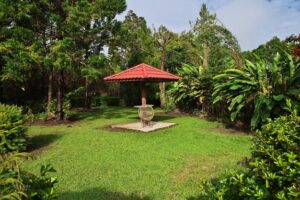The Psychology of Landscaping: How Design Influences Mood and Well-Being
Landscaping isn’t just about creating visually appealing outdoor spaces; it’s a deliberate art form that impacts our emotions, mental health, and overall well-being. The intricate connection between human psychology and landscape design has gained significant attention in recent years, shedding light on how our surroundings influence our mood and quality of life.

Nature’s Impact on Mental Health
- Biophilia and Connection: Humans have an innate affinity for nature, known as biophilia. Being surrounded by greenery, natural elements, and open spaces can evoke positive emotions, reduce stress, and improve cognitive function.
This inherent connection with nature, deeply ingrained in our evolutionary history, is more than just a preference; it’s a fundamental need.
Studies have shown that exposure to green spaces can result in faster recovery times from illness and surgery, highlighting the healing power of nature.
Moreover, children who grow up with access to natural environments tend to exhibit better concentration, creativity, and emotional resilience.
Biophilia isn’t merely a pleasant aesthetic choice; it’s a vital component for our physical, mental, and emotional well-being, reminding us of our intrinsic ties to the natural world.
- Stress Reduction: Studies show that exposure to natural environments can lower cortisol levels, the stress hormone. Gardens, parks, or well-designed outdoor spaces act as sanctuaries, providing solace from daily stressors.
The impact of nature on stress reduction extends beyond just cortisol levels. Engaging with natural environments triggers the parasympathetic nervous system, promoting relaxation and reducing the overall physiological markers of stress.
It’s not merely the absence of stress but the active restoration of our body’s equilibrium that makes time spent in these settings so rejuvenating.
Whether it’s the gentle rustle of leaves, the sight of flowing water, or the earthy scent of soil, these sensory experiences play a crucial role in calming our minds and bodies.
Hence, these sanctuaries in the form of gardens and parks aren’t merely spaces; they’re therapeutic landscapes that offer a respite from the frenetic pace of modern life, allowing us to recharge and reconnect with our inner selves.
Elements of Landscape Design
- Colour Psychology: The choice of colours in landscaping can profoundly impact emotions. Vibrant flowers can evoke feelings of joy and vitality, while serene blues and greens promote relaxation and calmness. Beyond the emotional responses triggered by colours, their psychological influence is deeply rooted in cultural and personal associations.
For instance, warm tones like reds and yellows may signify energy and passion for some, while for others, they might evoke a sense of urgency or intensity. Similarly, cooler tones such as blues and purples might symbolize tranquillity and spirituality to one individual but might evoke feelings of coldness or detachment to another.
Understanding these subjective interpretations of colours allows landscapers to create tailored experiences, ensuring that the chosen colour palette resonates harmoniously with the intended emotional and cultural context of the space.
The interplay of colours in landscaping isn’t just about aesthetics; it’s a nuanced language that communicates and influences emotions in multifaceted ways.
- Texture and Shape: The texture and shape of plants and features within a landscape influence perception. Soft, rounded shapes and diverse textures can create a sense of comfort and interest.
In landscaping, the deliberate selection of textures and shapes transcends mere visual appeal; it engages our tactile senses and influences our spatial perceptions.
The juxtaposition of smooth, velvety leaves against rough, rugged bark or the contrast between flowing grasses and structured hardscape elements like stones or pathways creates a symphony of sensations.
These tactile experiences not only add depth and richness to the landscape but also invite interaction. They encourage exploration and contemplation, inviting individuals to touch, feel, and immerse themselves in the environment.
This tactile diversity doesn’t just cater to our visual senses; it enriches our experience, fostering a deeper connection with the outdoor space and, in turn, nurturing a sense of belonging and tranquility.
Role of Landscaping in Residential Spaces
- Enhanced Living Spaces: Thoughtful landscaping design extends a home’s living space. Well-designed gardens or outdoor areas become retreats, inviting relaxation and socialization.
- Personalization and Expression: Landscaping allows homeowners to express their personalities and preferences. From minimalist designs to lush, tropical paradises, the landscape reflects individual tastes and lifestyles.
Impact on Commercial Spaces
- Productivity and Creativity: Offices with well-maintained green spaces witness increased productivity and creativity among employees. Access to nature during work hours positively affects focus and mood.
- Customer Experience: Businesses benefit from attractive landscapes. Retailers, restaurants, and hotels with appealing outdoor areas attract customers, enhancing their experience and encouraging longer stays.
Sustainable Landscaping and Well-Being
- Environmental Consciousness: Sustainable landscaping practices not only benefit the planet but also contribute to mental well-being. Knowing that the environment is cared for positively impacts our psyche.
- Natural Habitat Preservation: Incorporating native plants and creating habitats for local wildlife fosters a sense of connection with the ecosystem, promoting a deeper appreciation for nature.
Finding Balance in Urban Landscapes
- Urban Oasis: In bustling cities like Dubai, landscaping serves as an essential tool to create oases amid the urban jungle. Parks, green rooftops, and public gardens offer residents spaces to unwind and connect with nature.
- Integration of Technology: Innovative landscaping techniques, such as vertical gardens or smart irrigation systems, harmoniously blend technology with nature to create sustainable, functional, and aesthetically pleasing landscapes.
The Influence of a Professional Touch
Landscaping, when executed by professionals, takes on an entirely different dimension. A landscape company in Dubai understands the region’s unique climate, cultural aesthetics, and architectural styles, ensuring landscapes that thrive and captivate. Engaging the services of the best landscaping company in Dubai not only guarantees expertise but also an understanding of how design influences the region’s diverse population.
In conclusion, the psychology behind landscaping goes beyond visual appeal; it’s about creating environments that nurture our mental, emotional, and physical well-being. Whether it’s a residential haven or a commercial space, the intentional arrangement of elements within landscapes can significantly impact our mood, fostering a harmonious relationship between humans and their surroundings. As we recognize the profound effects of landscaping on our well-being, prioritizing thoughtful design becomes imperative for a healthier, happier society.












